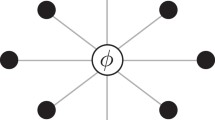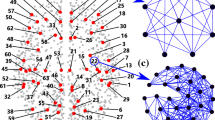Abstract
Remote synchronization (RS) has recently received an increasing interest in the systems of nonidentical oscillators, but little attention has been paid to the systems of identical oscillators such as the case of human cerebral cortex where RS takes a key role in the functions of brain. Based on the real network of human cerebral cortex, we here show that RS can be also observed in the systems of identical oscillators, provided that appropriate time delay is considered. We interestingly find that RS may appear in different local places of cerebral cortex and thus results in a diversity of patterns, i.e., a new framework of multiple starlike graphs connected by common leaf nodes. To understand its mechanism, we present a model of two starlike graphs connected by common leaf nodes. We further show that the common leaf nodes take a key role for the emergence of RS in the new framework. A theoretical analysis is given. These findings may be helpful to understand the segregation and integration processes of information transmission in brain.








Similar content being viewed by others
References
Ito, T., Kulkarni, K.R., Schultz, D.H., Mill, R.D., Chen, R.H., Solomyak, L.I., Cole, M.W.: Cognitive task information is transferred between brain regions via resting-state network topology. Nat. Commun. 8, 1027 (2017)
Del Ferraro, G., Moreno, A., Min, B., Morone, F., Perez-Ramirez, U., Perez-Cervera, L., Parra, L.C., Holodny, A., Canals, S., Makse, H.A.: Finding influential nodes for integration in brain networks using optimal percolation theory. Nat. Commun. 9, 2274 (2018)
Hagmann, P., Cammoun, L., Gigandet, X., Meuli, R., Honey, C.J., Wedeen, V.J., Sporns, O.: Mapping the structural core of human cerebral cortex. PLoS Biol. 6, 1479 (2008)
Ma, J., Tang, J.: A review for dynamics in neuron and neuronal network. Nonlinear Dyn. 89, 1569 (2017)
Jia, Y., Gu, H.: Identifying nonlinear dynamics of brain functional networks of patients with schizophrenia by sample entropy. Nonlinear Dyn. 96, 2327 (2019)
Liu, Z., Wang, C., Jin, W., Ma, J.: Capacitor coupling induces synchronization between neural circuits. Nonlinear Dyn. 97, 2661 (2019)
Ozer, M., Uzuntarla, M., Agaoglu, S.N.: Effect of the sub-threshold periodic current forcing on the regularity and the synchronization of neuronal spiking activity. Phys. Lett. A 360, 135 (2006)
Uzuntarla, M., Torres, J.J., Calim, A., Barreto, E.: Synchronization-induced spike termination in networks of bistable neurons. Neural Netw. 110, 131 (2019)
Sporns, O.: Network attributes for segregation and integration in the human brain. Curr. Opin. Neurobiol. 23, 162 (2013)
Park, H.J., Friston, K.: Structural and functional brain networks: from connections to cognition. Science 342, 6158 (2013)
Bullmore, E., Sporns, O.: Complex brain networks: graph theoretical analysis of structural and functional systems. Nat. Rev. Neurosci. 10, 186 (2009)
Sporns, O.: Contributions and challenges for network models in cognitive neuroscience. Nat. Neurosci. 17, 652 (2014)
Hipp, J.F., Engel, A.K., Siegel, M.: Oscillatory synchronization in large-scale cortical networks predicts perception. Neuron 69, 387 (2011)
Roelfsema, P.R., Engel, A.K., Konig, P., Singer, W.: Visuomotor integration is associated with zero time-lag synchronization among cortical areas. Nature 385, 157 (1997)
Vogels, T.P., Abbott, L.F.: Signal propagation and logic gating in networks of integrate-and-fire neurons. Neuroscience 25, 10786 (2005)
Diesmann, M., Gewaltig, M.O., Aertsen, A.: Stable propagation of synchronous spiking in cortical neural networks. Nature 402, 529 (1999)
Singer, W.: Neuronal synchrony: a versatile code for the definition of relations? Neuron 24, 49 (1999)
Womelsdorf, T., Schoffelen, J.M., Oostenveld, R., Singer, W., Desimone, R., Engel, A.K., Fries, P.: Modulation of neuronal interactions through neuronal synchronization. Science 316, 1609 (2007)
Arenas, A., Diaz-Guilera, A., Kurths, J., Moreno, Y., Zhou, C.: Synchronization in complex networks. Phys. Rep. 469, 93 (2008)
van Vreeswijk, C.: Partial synchronization in populations of pulse-coupled oscillators. Phys. Rev. E 54, 5522 (1996)
Bansal, K., Garcia, J.O., Tompson, S.H., Verstynen, T., Vettel, J.M., Muldoon, S.F.: Cognitive chimera states in human brain networks. Sci. Adv. 5, eaau8535 (2019)
Abrams, D.M., Strogatz, S.H.: Chimera states for coupled oscillators. Phys. Rev. Lett. 93, 174102 (2004)
Abrams, D.M., Mirollo, R., Strogatz, S.H., Wiley, D.A.: Solvable model for chimera states of coupled oscillators. Phys. Rev. Lett. 101, 084103 (2008)
Tian, C., Cao, L., Bi, H., Xu, K., Liu, Z.: Chimera states in neuronal networks with time delay and electromagnetic induction. Nonlinear Dyn. 93, 1695 (2018)
Huo, S., Tian, C., Kang, L., Liu, Z.: Chimera states of neuron networks with adaptive coupling. Nonlinear Dyn. 96, 75 (2019)
Calim, A., Hovel, P., Ozer, M., Uzuntarla, M.: Chimera states in networks of type-I Morris–Lecar neurons. Phys. Rev. E 98, 062217 (2018)
Rattenborg, N.C., Amlaner, C.J., Lima, S.L.: Behavioral, neurophysiological and evolutionary perspectives on unihemispheric sleep. Neurosci. Biobehav. Rev. 24, 817 (2000)
Mathews, C.G., Lesku, J.A., Lima, S.L., Amlaner, C.J.: Asynchronous eye closure as an anti-predator behavior in the western fence lizard (Sceloporus occidentalis. Ethology 112, 286 (2006)
Pikovsky, A., Rosenblum, M.: Partially integrable dynamics of hierarchical populations of coupled oscillators. Phys. Rev. Lett. 101, 264103 (2008)
Ma, R., Wang, J., Liu, Z.: Robust features of chimera states and the implementation of alternating chimera states. Europhys. Lett. 91, 40006 (2010)
Tamaki, M., Bang, J.W., Watanabe, T., Sasaki, Y.: Night watch in one brain hemisphere during sleep associated with the first-night effect in humans. Curr. Biol. 26, 1190 (2016)
Schaub, M.T., O’Clery, N., Billeh, Y.N., Delvenne, J.C., Lambiotte, R., Barahona, M.: Graph partitions and cluster synchronization in networks of oscillators. Chaos 26, 094821 (2016)
Cao, B., Wang, Y.F., Wang, L., Yu, Y.Z., Wang, X.G.: Cluster synchronization in complex network of coupled chaotic circuits: an experimental study. Front. Phys. 13, 130505 (2018)
Sorrentino, F., Pecora, L.M., Hagerstrom, A.M., Murphy, T.E., Roy, R.: Complete characterization of the stability of cluster synchronization in complex dynamical networks. Sci. Adv. 2, e1501737 (2016)
Pecora, L.M., Sorrentino, F., Hagerstrom, A.M., Murphy, T.E., Roy, R.: Cluster synchronization and isolated desynchronization in complex networks with symmetries. Nat. Commun. 5, 4079 (2014)
Siddique, A.B., Pecora, L., Hart, J.D., Sorrentino, F.: Symmetry-and input-cluster synchronization in networks. Phys. Rev. E 97, 042217 (2018)
Williams, C.R., Murphy, T.E., Roy, R., Sorrentino, F., Dahms, T., Schöll, E.: Experimental observations of group synchrony in a system of chaotic optoelectronic oscillators. Phys. Rev. Lett. 110, 064104 (2013)
Bergner, A., Frasca, M., Sciuto, G., Buscarino, A., Ngamga, E.J., Fortuna, L., Kurths, J.: Remote synchronization in star networks. Phys. Rev. E 85, 026208 (2012)
Minati, L.: Remote synchronization of amplitudes across an experimental ring of non-linear oscillators. Chaos 25, 123107 (2015)
Hart, J.D., Bansal, K., Murphy, T.E., Roy, R.: Experimental observation of chimera and cluster states in a minimal globally coupled network. Chaos 26, 094801 (2016)
Cho, Y.S., Nishikawa, T., Motter, A.E.: Stable chimeras and independently synchronizable clusters. Phys. Rev. Lett. 119, 084101 (2017)
Schmidt, L., Krischer, K.: Clustering as a prerequisite for chimera states in globally coupled systems. Phys. Rev. Lett. 114, 034101 (2015)
Majhi, S., Perc, M., Ghosh, D.: Chimera states in a multilayer network of coupled and uncoupled neurons. Chaos 27, 073109 (2017)
Bassett, D.S., Bullmore, E.D.: Small-world brain networks. Neuroscientist 12, 512 (2006)
Perl, E.R.: The Thalamus. Cambridge University Press, Cambridge (2007)
Viriyopase, A., Bojak, I., Zeitler, M., Gielen, S.: When long-range zero-lag synchronization is feasible in cortical networks. Front. Comput. Neurosci. 6, 49 (2012)
Fischer, I., Vicente, R., Buldu, J.M., Peil, M., Mirasso, C.R., Torrent, M.C., Garcia-Ojalvo, J.: Zero-lag long-range synchronization via dynamical relaying. Phys. Rev. Lett. 97, 123901 (2006)
Vicente, R., Gollo, L.L., Mirasso, C.R., Fischer, I., Pipa, G.: Dynamical relaying can yield zero time lag neuronal synchrony despite long conduction delays. Proc. Natl. Acad. Sci. USA 105, 17157 (2008)
Sherman, S.M., Guillery, R.W.: Exploring the Thalamus and Its Role in Cortical Function. Academic Press, Cambridge, MA (2006)
Lagier, S., Carleton, A., Lledo, P.M.: Interplay between local GABAergic interneurons and relay neurons generates \(\gamma \) oscillations in the rat olfactory bulb. J. Neurosci. 24, 4382 (2004)
Seki, K., Perlmutter, S.I., Fetz, E.E.: Sensory input to primate spinal cord is presynaptically inhibited during voluntary movement. Nat. Neurosci. 6, 1309 (2003)
Vlasov, V., Bifone, A.: Hub-driven remote synchronization in brain networks. Sci. Rep. 7, 10403 (2017)
Gambuzza, L.V., Cardillo, A., Fiasconaro, A., Fortuna, L., Gomez-Gardenes, J., Frasca, M.: Analysis of remote synchronization in complex networks. Chaos 23, 043103 (2013)
Gambuzza, L.V., Frasca, M., Fortuna, L., Boccaletti, S.: Inhomogeneity induces relay synchronization in complex networks. Phys. Rev. E 93, 042203 (2016)
Nicosia, V., Valencia, M., Chavez, M., Diaz-Guilera, A., Latora, V.: Remote synchronization reveals network symmetries and functional modules. Phys. Rev. Lett. 110, 174102 (2013)
Hagmann, P., Kurant, M., Gigandet, X., Thiran, P., Wedeen, V.J., Meuli, R., Thiran, J.P.: Mapping human whole-brain structural networks with diffusion MRI. PLoS ONE 2, e597 (2007)
Iturria-Medina, Y., Sotero, R.C., Canales-Rodriguez, E.J., Aleman-Gomez, Y., Melie-Garcia, L.: Studying the human brain anatomical network via diffusion-weighted MRI and graph theory. Neuroimage 40, 1064 (2007)
Honey, C.J., Sporns, O., Cammoun, L., Gigandet, X., Thiran, J.P., Meuli, R., Hagmann, P.: Predicting human resting-state functional connectivity from structural connectivity. Proc. Natl. Acad. Sci. USA 106, 2035 (2009)
Aguirre, G.K., Zarahn, E., D’esposito, M.: The inferential impact of global signal covariates in functional neuroimaging analyses. Neuroimage 8, 302 (1998)
Izhikevich, E.M.: Polychronization: computation with spikes. Neural Comput. 18, 245 (2006)
Adhikari, B.M., Prasad, A., Dhamala, M.: Time-delay-induced phase-transition to synchrony in coupled bursting neurons. Chaos 21, 023116 (2011)
Dhamala, M., Jirsa, V.K., Ding, M.: Enhancement of neural synchrony by time delay. Phys. Rev. Lett. 92, 074104 (2004)
Wendling, F., Bellanger, J.J., Bartolomei, F., Chauvel, P.: Relevance of nonlinear lumped-parameter models in the analysis of depth-EEG epileptic signals. Biol. Cybern. 83, 367 (2000)
Zhou, C., Zemanova, L., Zamora-Lopez, G., Hilgetag, C.C., Kurths, J.: Structure function relationship in complex brain networks expressed by hierarchical synchronization. New J. Phys. 9, 178 (2007)
Wilson, H.R., Cowan, J.D.: Excitatory and inhibitory interactions in localized populations of model neurons. Biophys J. 12, 1 (1972)
Daffertshofer, A., van Wijk, B.C.M.: On the influence of amplitude on the connectivity between phases. Front Neuroinform. 5, 8 (2011)
Hoppensteadt, F.C., Izhikevich, E.M.: Weakly Connected Neural Networks, 1st edn. Springer, New York (1997)
Sherman, A., Rinzel, J.: Rhythmogenic effects of weak electrotonic coupling in neuronal models. Proc. Natl. Acad. Sci. USA 89, 2471 (1992)
Steyn-Ross, D.A., Steyn-Ross, M., Freeman, W. (eds.): Modeling Phase Transitions in the Brain, 1st edn. Springer, New York (2010)
Moon, J., Lee, U., Blain-Moraes, S., Mashour, G.A.: General relationship of global topology, local dynamics, and directionality in large-scale brain networks. PLOS Comput. Biol. 11, e1004225 (2015)
Acknowledgements
This work was partially supported by the NNSF of China under Grant Nos. 11675056 and 11835003.
Author information
Authors and Affiliations
Corresponding author
Ethics declarations
Conflict of interest
The authors declare that they have no competing interests.
Additional information
Publisher's Note
Springer Nature remains neutral with regard to jurisdictional claims in published maps and institutional affiliations.
Rights and permissions
About this article
Cite this article
Kang, L., Wang, Z., Huo, S. et al. Remote synchronization in human cerebral cortex network with identical oscillators. Nonlinear Dyn 99, 1577–1586 (2020). https://doi.org/10.1007/s11071-019-05375-x
Received:
Accepted:
Published:
Issue Date:
DOI: https://doi.org/10.1007/s11071-019-05375-x




